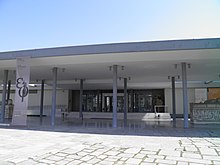Archaeological Museum of Thessaloniki
The Archaeological Museum of Thessaloniki ( Greek Αρχαιολογικό Μουσείο Θεσσαλονίκης ) exhibits a collection of archaeological finds from Thessaloniki and the region of Macedonia . The managing director is Angeliki Koukouvou .
location
The museum is located in the city center, west of the exhibition halls and north of the town hall on Manoli-Andronikou-Straße. It takes up the entire area between Leof. Stratou, Manoli-Andronikou Street and the Street of September 3rd.
history
The foundation of the museum dates back to 1912 when the Ottoman city was conquered by the Greeks. Until 1925, all of the region's ancient finds were kept in the city's Konak and Aristotle University . In 1925, the city's archaeological service received the Yeni Cami , the mosque of the Dönme , which were attributed to the Turks and had to leave the city. The mosque became the first museum of Thessaloniki and is still a place for temporary exhibitions. During the Second World War, many exhibits, especially statues, were buried to hide them from the German occupation forces. It was not dug up again until 1951 and first exhibited in the new archaeological museum in 1953.
As early as 1950, it was decided to dedicate a new building to the museum. The Greek Patroklos Karantinos was chosen as the architect . In 1962 the building was officially opened with an exhibition of the finds from the Derveni graves . With the discovery of the royal tombs of Vergina , the museum received further valuable treasures. In the meantime, the museum's collection had grown so much that an extension became necessary in the early 1980s. In 1982 the exhibition had to be expanded to include the finds from the Sindos cemetery . In 1985 the museum organized a first exhibition on the history and archeology of the city to mark the 2300th anniversary of the founding of Thessaloniki. The finds from Vergina, which included the grave of Philip II , the father of Alexander the Great , were moved to the newly built museum in Vergina in 1997.
In 2002 the Archaeological Museum was placed directly under the Ministry of Culture by decree of the President. At the same time, the building was extensively renovated and expanded until 2004. In September 2006, the museum was reopened with five new thematically structured exhibitions. The exhibition sheds light on the history of Thessaloniki and Macedonia from prehistoric times to late antiquity.
building
The museum building was started in the late 1950s and opened in 1962. The plans came from the renowned Greek architect Patroklos Karantinos. Since 2003, the building complex has been a listed building as an example of modern architecture in Greece. The building was rebuilt, modernized and supplemented several times. The central building complex was built in a square around an atrium. The flat roof is supported by narrow round columns. In front of the building there is a wide protective roof. The facade facing the inner courtyard is largely glazed. In 1980 the building received slight changes and additions by the architect Vogiatzis. In the 2000s the building was changed again. Architect N. Fyntikakis left the exterior untouched, the interior was modernized and remodeled.
Collection and exhibitions
The house's collection consists mainly of finds from Thessaloniki and the Macedonia region. The most significant exhibits include the finds from the tombs of Sindos, Agia Paraskevi , Nea Filadelfia , Makrygialos , Derveni , Lete , Serres and Evropos . The oldest finds include artifacts from the Neolithic and the Early and Late Bronze Ages. The core of the collection also includes sculptures from the Archaic and Roman times. You can also see parts of an Ionic temple from the 6th century BC, parts of the palace of Galerius and a reconstruction of the facade of a Macedonian tomb in Agia Paraskevi with original pieces, as well as gold finds from the classical and archaic periods from tombs in Sindos.
The museum now has seven thematic exhibition sections: Prehistoric Macedonia , On the Way to Cities (early settlements in the Iron Age), Macedonia from 700 BC. BC to late antiquity , Thessaloniki - Macedonia's capital , the gold of Macedonia , Macedonia - from fragments to pixels (interactive exhibition), an open-air exhibition on houses and tombs in Thessaloniki and memory in stone (open-air exhibition too Statues from the period between the 1st and 7th centuries AD).
In addition, the museum shows temporary exhibitions.
Web links
- Museum website
- The Archaeological Museum of Thessaloniki at the Association of Mediterranean Museums
Individual evidence
- ^ Museum database of the Greek Ministry of Culture and Sport
Coordinates: 40 ° 37 ′ 30.4 ″ N , 22 ° 57 ′ 13.7 ″ E


